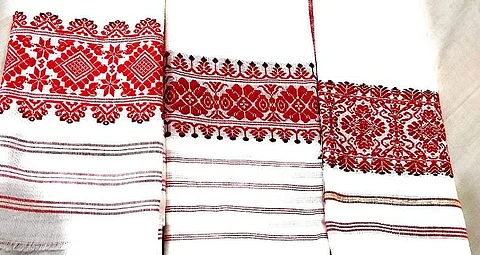
- Home
- Live Blog
- Breaking News
- Top Headlines
- Cities
- NE News
- Sentinel Media
- Sports
- Education
- Jobs

Handloom gamosa is considered the symbol of the Assamese culture, and rightly so. What a gamosa has in it? Materially speaking, it is made of fabrics and nothing else. Its material value is fixed on the cost of the materials used and the labour put to in it by a weaver, besides the varying images of designs of the weaver webbed on it. Aesthetically speaking, gamosa has a lot and its worth is beyond measure. Apart from the fabric used and the labour put to in it, it has the dreams of the weaver etched on it. Mahatma Gandhi rightly said, “Assamese women weave dream on their looms.” The design is the artistic reflection of the dream of a weaver that gets etched on a gamosa. Can the dream of a weaver be evaluated in monetary value? What makes it worthy of becoming the symbol of the Assamese culture? Apart from the art and craft involved in it, the use of gamosa in the day-to-day personal, social and religious life of the Assamese is innumerable. It is an essential piece of value-added fabric that is necessary almost in every sphere in the Assamese culture like activities associated with birth, death, worship, marriage, and whatnot. No cultural and religious activity in Assamese social life is complete without the involvement of gamosa. It is the intrinsic value of gamosa in the life of the Assamese that makes it their cultural symbol.
The sad fact, however, remains that gamosa has all along been fighting a losing battle against its evil twins – a whole lot of powerloom gamosas of all hues that glut the market in Assam throughout the year, especially during the Bihu season. This is an unfair price war between the Assamese handloom gamosa and its powerloom counterparts entering the market in the state from the country’s other states that have made strides in textiles industry. Since a powerloom is capable of producing gamosas million times faster than what a handloom weaver can, powerloom gamosas can be sold at much cheaper prices than that of handloom ones. However, if it comes to durability and design, handloom gamosa is matchless. Driven by cheaper prices, the buyers in Assam, as often as not, opt for powerloom gamosas, especially when they go for bulk buying for programmes like felicitation in Bihu and other functions. Such organizers should think twice before buying powerloom gamosas as that has a damaging effect on the survival of the traditional weavers of the State who have been struggling hard to keep the torch of the cultural legacy burning. What will drive the local weavers to go ahead with weaving gamosas if the very trade does not give them remunerative prices so as to make them eke out a living? Is not it the responsibility of the State government and the Assamese community as a whole to keep the State’s cultural symbol and its producers alive? To protect the interests of traditional weavers the government has enacted the Handlooms (Reservation of Articles for Production) Act, 1985 that provides for the reservation of certain articles for exclusive production by handlooms. It prohibits the production of articles exclusively reserved for handlooms, by other means. It gives the Central government the power to summon information or samples of the textile articles as well as inspect and seize them. The Act includes a penalty for whoever produces articles or class of articles in contravention of the law which mandates that entities/companies be punished when an offence under this Act has been committed. By an order from the Ministry of Textiles, a sub-section in the Act reserves 11 classes of articles for exclusive production by handlooms. The order includes composition details and range to be reserved under handloom for various items, including dhoti, gamosa, angavastram, Manipuri phanek etc.
The officials of the State Textile department conduct raids in the State market every year during the Bihu season and seize powerloom gamosas from other states glutting the market here in Assam. However, since there is no scientific device for distinguishing a handloom gamosa from its powerloom evil twins, companies/entities producing powerloom gamosas cannot be dragged to the court. How come the authority concerned sits idle over the years by not devising a mechanism that can distinguish a handloom gamosa from its powerloom counterparts? A handloom weaver can detect powerloom gamosas at ease as such gamosas have no temple marks (putol pricks) along the parallel borders (breadth wise). Such pricks pierced by the ‘putol’ (an indigenous device that is used by a weaver to keep the breadth of a gamosa or a phanek intact) are not found in any powerloom gamosas. The moot point is: can this mechanism of distinguishing a handloom gamosa from its powerloom counterparts withstand the argument in the court? If it does not, why does not the authority devise a scientific mechanism that can withstand in the court of law? Does not this issue that has much to do with the survival of the cultural symbol of the Assamese deserve due attention from the AASU (All Assam Students’ Union) and other pressure groups of the State? Time is of the essence on such issues. We should bear this in mind that the problem of foreigners is complicated in the State now as the successive governments failed to take action, timely. We sincerely hope not, the issue of gamosa meets the same fate.